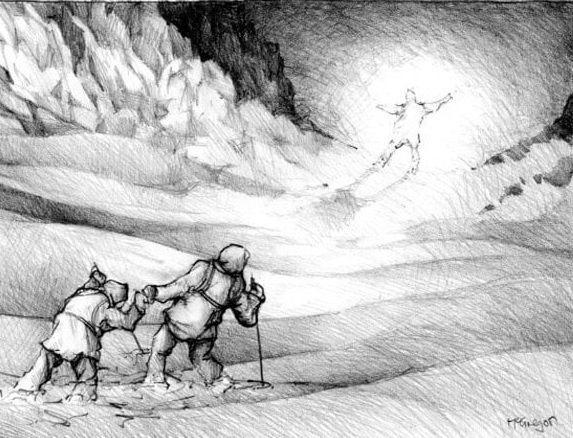The Petrozavodsk Phenomenon: Jellyfish UFO
A drawing of of the Petrozavodsk Jellyfish UFO by an Eyewitness. Photo: moviemaker
On September 20th, 1977 a series of bright, flying objects resembling jellyfish were reported in the skies over Eastern Europe and Scandinavia.
Sightings of the Petrozavodsk Jellyfish UFO
On the 20th September, 1977 many sightings of unidentified objects in the sky were reported to authorities across Eastern Europe and Scandinavia.
These objects varied in appearance from small, fast moving orbs of light that left behind a trail of smoke to large jellyfish shaped light forms.
At least 48 objects were reported between 1:00 and 1:20am UTC.
There were also sightings before 1:00am local time over Medvezhyegorsk, at 2:30 am over Loukhi, and at 3:00am over Kovdor and Palanga (Lithuania).
Between approximately 3:00 and 3:25 am, the supervising personnel of the Leningrad maritime trade port observed an unidentified luminous object.
At 3:30 am, the crew of the Soviet fishing vessel Primorsk reportedly saw a flying object surrounded by a luminous coat as it departed from the Primorsk harbor. The object appeared to move silently from the east and abruptly changed direction to the north near Primorsk.
Newspapers Ilta-Sanomat and Kansan Uutiset reported sightings of a glowing ball in Helsinki, Finland, on September 20th and 21st. Many residents, including taxi drivers, police officials, and Helsinki Airport personnel, claimed to have observed the ball.
Two men near Turku, Finland reported seeing an unidentified spinning object resembling a lifebuoy, approximately 10 meters in diameter, at a distance of 300 meters.
Ilta-Sanomat, a Finnish newspaper also reported a sighting of a glowing object over Copenhagen, Denmark, by the pilots of a Finnish airline aircraft flying from Rome.
Reports from eyewitnesses, including paramedics, on-duty militsiya officials, seamen, longshoremen at Petrozavodsk's port, military personnel, local airport staff, and an amateur astronomer, described bright, luminous bodies in the European part of the Soviet Union.
These bodies were surrounded by extended shells and emitted light rays or jets of peculiar shapes. The shells transformed and diffused within 10 to 15 minutes, while a more persistent and stable glow was observed, mostly in the northeastern part of the sky. This phenomenon was witnessed by various individuals in different professions and locations.
A. Novozhilov’s Sighting of the Jellyfish UFO
A photo taken of the Jellyfish UFO by Michael Heseman
Engineer A. Novozhilov reported seeing a luminous object in the settlement of Kurkijoki, which he initially thought was a meteor. He described the object as resembling an airship and reported the sighting to Konstantin Polevitsky, a candidate of technical sciences, who recorded it.
As time passed, the object stopped moving and then started moving towards Novozhilov, increasing in size and taking on the distinct shape of an airship.
The object had facets and was tipped with bright shining spots on the front and back, with the edges glowing with white light that was slightly fainter than the spots.
The facets looked like windows that were lit from the inside and glowed evenly with a white light that was fainter than the edges.
The object was approximately 100 meters long and 12-15 meters in diameter, moving at an altitude of 300-500 meters. As the object approached Novozhilov, it released a brightly shining ball from the rear that flew north, descending behind a forest and causing a bright glow upon landing.
Novozhilov attempted to take three photos of the sighting with a 0.1-second exposure at 4:15 am, but they were unsuccessful. He described the object as being "much larger than the moon" and moving at the speed of a helicopter. The observation lasted for about 10-15 minutes and occurred in complete silence.
Yuri Linnik’s Sighting of the Jellyfish UFO
Soviet writer and philosopher Yuri Linnik provided a detailed description of an unidentified object he observed at his dacha near Namoyevo around 3:00 am, using an amateur telescope with 80x magnification.
The object had a lens-like shape with a dim, translucent ring, and its color was described as a "dark amethyst, intensively lightened from inside". Linnik noted that the edges of the object had 16 spots, which he referred to as "nozzles", emitting pulsating red rays at an angle of 10°-15°.
The object stopped near Gamma Cephei at an azimuth of 220°, then changed direction near Kappa Coronae Borealis to 30°-35° west at an azimuth of 340°-350°. Finally, it disappeared in the north at an azimuth of 340° after a flight duration of 15 minutes.
Sightings of the Jellyfish UFO over Petrozavodsk
In 1974, Petrozavodsk, a city in the Karelian Autonomous Soviet Socialist Republic, was the capital and an important industrial center.
A large unidentified object was spotted over Petrozavodsk by many eyewitnesses, including a TASS correspondent named Nikolai Milov.
Milov described the object as a "huge star" that appeared in the sky around 4:00 am local time and emitted pulsating shafts of light towards the Earth. The object was also seen by other newspapers and eyewitnesses in adjacent places.
The object was initially seen in the northeastern part of the sky, below Ursa Major constellation, at an azimuth of about 40°. It appeared as a bright object, similar in brightness to Venus, and moved upwards towards Ursa Major.
As it moved, it expanded and pulsated, but did not decrease in brightness. After about three minutes, the object stopped and dispersed a bright cloud, which was round or oval in shape and had a diameter larger than that of Ursa Major.
he altitude of the object during the formation of the cloud was estimated to be around 7.5 km or 6.0 km based on different observations.
The object was red in color and emitted a bluish white glow, illuminating the area like a full moon. The glowing cloud then developed a dark spot around the central core, which expanded while the glow faded away.
The object hovered over Petrozavodsk for about five minutes before moving away. During hovering, its speed was similar to that of a passenger aircraft, and one eyewitness noted that its underside resembled a Segner wheel. The entire phenomenon lasted for about 10-15 minutes and was also observed in adjacent places.
In 1978, a color reconstruction of various stages of the object was published in Tekhnika i Nauka, a scientific and technical magazine.
The eyewitness reports and preliminary data analysis by the Academy of Sciences of the USSR in 1977 found the observations to be consistent and complementary. Some of the details of the object's size and shape were estimated based on drawings and descriptions provided by eyewitnesses.
In November 1977, a clinical psychologist named Y. Andreyeva evaluated the mental health of nine eyewitnesses of the Petrozavodsk phenomenon and concluded that they were mentally stable and their testimonies were truthful.
Strange Effects of the Jellyfish UFO
There were reports of the phenomenon having a strange impact on humans and the environment.
Some eyewitnesses observed that the air above the lake in Petrozavodsk glowed with white light after the glowing yellow ball disappeared, and the glow was even brighter than the city lights.
There were also reports of increased biological activity in the areas where the phenomenon was observed, such as blooming of roses and herbaceous plants, which was considered unusual for the region.
Some engineers in the Petrozavodsk area reported "huge failures" in computing devices during the phenomenon, which later returned to normal functioning.
Investigation into the Petrozavodsk Jellyfish UFO
In 1977, Lev Gindilis, a researcher at the Sternberg Astronomical Institute, analyzed testimonies and meteorological data related to a phenomenon observed in Petrozavodsk, Russia.
He suggested that the object observed could have been at an altitude of around 100 kilometers or higher, with a minimum size of about 1 kilometer and a diameter of several tens of kilometers.
He also pointed out that the observed motion of the object did not match the expected trajectory of the Soviet satellite Kosmos-955, which had been launched to the northeast.
In October 1977, a local hydrometeostation further confirmed the southwest motion of the object. In 1978, an expert group was dispatched to Petrozavodsk to study the phenomenon on-site, and an updated report was compiled. Copies of the report were sent to foreign research groups, including one to GEPAN in France and another to CUFOS in the United States.
The reception of the Soviet report abroad was mixed, with some considering it as evidence of unidentified flying objects (UFOs), while others criticized it as a possible Soviet attempt to divert attention from their own UFO activities. James Oberg was particularly critical of the Soviet investigation.
The initial analysis and subsequent investigations were inconclusive and did not provide a definitive explanation for the Petrozavodsk phenomenon.
Possible Explanations for the Petrozavodsk Phenomenon
Many explanations have been proposed to explain the phenomenon observed over Petrozavodsk. At first, some experts thought it was caused by a meteorite or aurorae, but these explanations were later challenged.
Vladimir Krat, the director of the Pulkovo Observatory, initially attributed it to a meteorite, but later changed his view to aurorae. Vladimir Migulin, the director of IZMIRAN, also supported the aurorae explanation, but this was rejected by Felix Ziegel, who argued that aurorae cannot occur at the altitude and brightness observed in Petrozavodsk.
Migulin then suggested that the phenomenon was caused by a combination of factors, including the launch of the satellite Kosmos-955, magnetic perturbations from a solar flare, and a scientific experiment involving low frequency radio waves on the ionosphere.
In an interview, Matti Kivinen from the Nurmijärvi geophysical observatory speculated that the object could be debris from a launch vehicle or satellite.
James Oberg attributed the phenomenon to the launch of Kosmos-955 from Plesetsk Cosmodrome, which caused a blaze trail visible from Petrozavodsk due to the direction of the launch.
Yuli Platov, a fellow from IZMIRAN, endorsed Oberg's view and linked the phenomenon to the satellite's engine flare and passage through the turbopause boundary.
In a later article, Platov also mentioned the possibility of an unsuccessful test launch of a ballistic missile in the same region at the same time, but this argument remains contested.
Another hypothesis proposed by M. Dmitriyev in Aviatsiya i Kosmonavtika suggested that the phenomenon was a chemiluminescent area in the atmosphere, but Ziegel criticized this explanation, stating that the energy output of chemiluminescence is too low compared to the observed brightness and movement of the object.
Ukrainian researcher Oleh Pruss, who has experience with rocket launches, stated that the phenomenon observed over Petrozavodsk was different from what is typically seen during rocket launches. Further investigation and research is needed to determine the true nature of the phenomenon.
No definitive explanation for the phenomenon exists to this day.
What do you think caused the Jellyfish UFO over Petrozavodsk? Let us know in the comments.


































